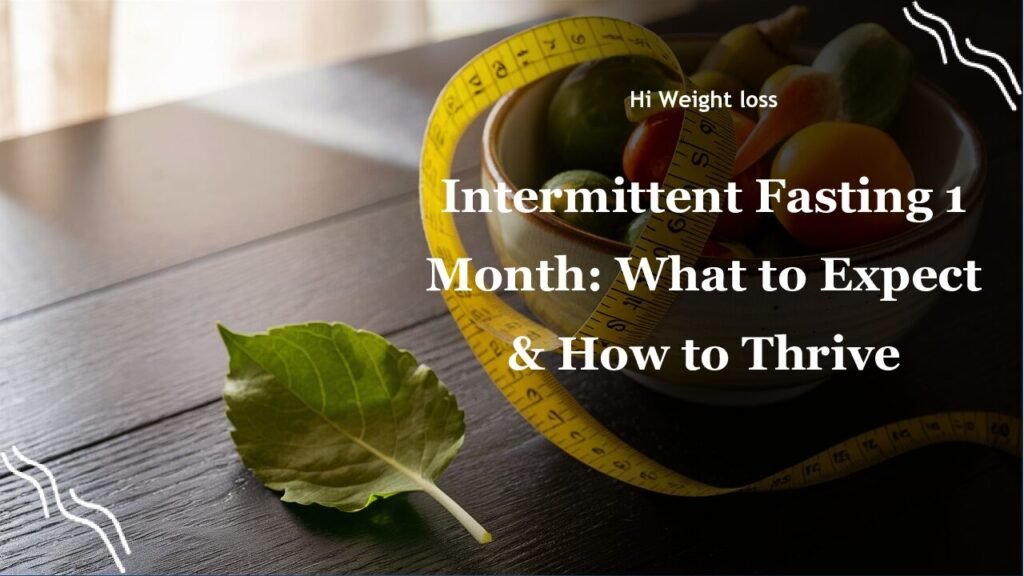“`
Starting a new diet can be daunting, especially when it involves a significant change like intermittent fasting. You might be wondering, “What happens after 1 month of intermittent fasting?” Will I see results? Will it be sustainable? This article will guide you through the potential changes, both positive and negative, that you might experience, drawing on scientific research and personal insights to give you a clear picture of what to expect from a month of intermittent fasting, and help you to find your own healthy way.
What Happens After 1 Month of Intermittent Fasting?
The Upsides: Positive Changes You Might See
One of the most sought-after benefits of intermittent fasting is weight loss. Many people, including those following the 20/4 method, where you fast for 20 hours and eat within a 4-hour window, find that this structured fasting protocol helps them achieve a natural calorie deficit. I remember a friend telling me that after just a few weeks of following a 16/8 intermittent fasting plan, she noticed her clothes fitting looser. She wasn’t even trying to restrict her calories during her eating window, but the reduced eating time naturally led to her consuming less. It’s a great feeling when your efforts start to show!
Beyond weight loss, intermittent fasting can also lead to improved health indicators. Participants in fasting schedules often report enhanced mental clarity and better metabolic health. This might mean lower blood pressure, reduced resting heart rate, and other improvements in heart-related measurements. According to research, intermittent fasting can also boost working memory in animals and verbal memory in adult humans. This suggests it can improve cognitive function over time. Think of it as a mental reset button alongside the physical benefits!

Navigating the Challenges: Potential Negative Changes
It’s important to be aware that the first month of intermittent fasting might not be all smooth sailing. Your body needs time to adjust, and it might take two to four weeks to get used to the new eating schedule. During this time, you might experience headaches, hunger pangs, crankiness, and tiredness. I’ve experienced it myself. The first week was the hardest—I felt constantly hungry and irritable. But by the second week, it got much easier, and by the end of the month, I felt like it was my normal routine.
Another potential issue is overeating. When your body is deprived of food for extended periods, your appetite hormones and hunger centers in the brain can go into overdrive. This can lead to some unhealthy dietary habits on non-fasting days. For example, a friend found that she’d overindulge on high-calorie foods during her eating window because she felt deprived during fasting hours. She quickly realized the importance of balanced eating, even during her allocated eating time. It’s not just about when you eat, but what you eat.
Nutritional deficiencies are another concern. If you don’t consume enough calories or nutrient-rich foods during your eating window, your body may store more fat for the long term. This is a survival mechanism, where the body conserves energy to ensure a reliable fuel source when food isn’t readily available. This happened to me. In the beginning, I wasn’t paying enough attention to the types of foods I was eating. I was just focusing on getting enough calories in during my eating window. After a while, my body felt sluggish and I realized I was actually gaining weight instead of losing it. So, it’s important to focus on nutrient-dense foods, even with intermittent fasting.
How to Maintain Weight Loss After 1 Month of Intermittent Fasting?
Maintaining weight loss after a month of intermittent fasting involves a blend of mindful eating and continued adherence to a sustainable fasting schedule. It’s not just about the initial results; it’s about building healthy habits that support long-term wellness. For example, integrating a balanced diet with plenty of fruits, vegetables, and lean proteins during your eating window is crucial. Avoid the temptation to overindulge in processed foods or sugary treats, as these can hinder your progress and leave you feeling unsatisfied in the long run.
Regular physical activity is another cornerstone of sustainable weight management. Incorporating exercise into your routine, whether it’s a brisk walk, a gym workout, or a yoga session, will not only help you burn extra calories but also boost your metabolism and overall fitness. Listen to your body and adjust the intensity and type of activity to suit your fitness level, and make sure that the exercise routine is one that you enjoy so that it is sustainable in the long run.
Another key aspect of maintaining weight loss is consistency. Sticking to your chosen intermittent fasting schedule and eating pattern will help regulate your body’s metabolism and prevent rebound weight gain. Be patient with yourself and allow for slight fluctuations in your weight, as this is a normal part of the process. Most importantly, if you find that intermittent fasting is too difficult to maintain, or the eating pattern it promotes isn’t right for you, don’t be afraid to modify your approach so that it better aligns with your needs and lifestyle, and do consult with a healthcare professional to discuss your weight-loss plans. Remember, sustainable weight loss is about finding a healthy routine that works for you.
Physical Changes After 1 Month of Intermittent Fasting
After a month of intermittent fasting, you might notice several physical changes beyond weight loss. Your clothes might fit better, and you may observe a leaner physique due to the metabolic switch that occurs when your body exhausts its sugar stores and begins burning fat. This is often described as a more efficient and effective way of utilizing energy. According to research published by Hopkins Medicine, this metabolic switch not only leads to a leaner body, but can also sharpen your mind. It can make you feel more energized and focused throughout your day.
You might also notice improvements in your skin. Some people have reported clearer skin after adopting intermittent fasting, possibly due to reduced inflammation in the body. In a study done by Family Doctor, intermittent fasting has been associated with a range of health benefits, including protection against chronic diseases like type 2 diabetes, heart disease, age-related neurodegenerative disorders, inflammatory bowel disease, and many cancers. It is essential to note that the physical changes can be different for everyone. It’s important to listen to your body and consult with a healthcare professional for advice.
Understanding the Metabolic Switch
The concept of a “metabolic switch” is central to the benefits of intermittent fasting. After hours without food, your body depletes its glycogen stores (stored sugar) and starts burning fat for energy. This is a powerful shift that not only promotes weight loss but also improves metabolic health. The metabolic switch has been widely discussed in various medical studies, such as one reported on by Harvard Health. The process is not just about losing weight; it’s about optimizing how your body uses energy. When you switch to burning fat, you’re using a more efficient fuel source. This can contribute to improved mental clarity and sustained energy levels.
The metabolic switch can also contribute to better blood sugar control. By reducing the demand on your body to constantly process glucose, intermittent fasting can improve insulin sensitivity. This can lower the risk of developing type 2 diabetes. Additionally, this mechanism enhances overall metabolic health, reduces inflammation, and promotes cellular repair. You can learn more about the science behind the metabolic switch from the resources I have cited, including the Chatswood Medical Centre. Ultimately, the metabolic switch is an efficient way of making your body work more effectively and optimizing your energy output.
General Health Benefits and Disease Prevention
Intermittent fasting has been linked to many health benefits beyond weight loss. Studies suggest it can offer protection against a range of chronic diseases, such as type 2 diabetes, heart disease, age-related neurodegenerative disorders, inflammatory bowel disease, and even certain types of cancer. While more research is needed in this area, the preliminary results are promising. Intermittent fasting may trigger a cellular repair process called autophagy, which helps to remove damaged cells and promote cellular regeneration. This process is believed to be involved in the prevention of age-related diseases, as cited by the study done by Hopkins Medicine.
Furthermore, intermittent fasting can improve heart health by lowering blood pressure, cholesterol, and triglyceride levels. Improved metabolic health has a cascading effect on the entire body. However, it’s not a magical cure-all; it’s a tool that can enhance health when combined with other healthy lifestyle choices, like eating a balanced diet and doing regular exercise. It’s always best to consult with a healthcare professional to ensure it’s the right fit for your individual health needs.
A Summary of Benefits and Challenges
Here is a quick summary of the potential positive and negative changes you might experience after one month of intermittent fasting. It’s always best to stay informed about your wellness journey, and this is a great way to keep track of your progress:
| Potential Benefits | Potential Challenges |
|---|---|
| Weight Loss | Adjustment Period (headaches, hunger, crankiness) |
| Improved Mental Clarity | Risk of Overeating |
| Better Metabolic Health (Blood pressure, heart rate) | Nutritional Deficiencies if eating window is not focused on nutrient-rich foods |
| Enhanced Cognitive Function | |
| Protection against certain diseases |
Conclusion
After one month of intermittent fasting, you may experience some significant changes in your body and mind. The positive changes might include weight loss, improved health indicators, and enhanced cognitive function. On the other hand, there can be an adjustment period with challenges such as headaches, hunger, crankiness, and even the risk of overeating or nutritional deficiencies. It’s essential to approach intermittent fasting with caution and under the guidance of a healthcare professional, especially if you have any underlying health conditions. The key to success with intermittent fasting is to listen to your body, adjust your approach as needed, and prioritize a balanced diet and exercise routine.
Remember my friend, who initially struggled with overeating during her eating window? She eventually found success by incorporating more nutrient-dense foods and being more mindful about her choices. This underscores that it’s not just about *when* you eat, but also *what* you eat. Don’t be afraid to start slow and be kind to yourself throughout this journey. The goal is to integrate intermittent fasting into a lifestyle, and not view it as a temporary diet. If you have a friend who has been asking what happens after 1 month of intermittent fasting, or if you are someone who is wondering that, feel free to share this post with them to help them understand better.
FAQ
Is intermittent fasting safe for everyone?
Intermittent fasting is not suitable for everyone, especially pregnant women, individuals with a history of eating disorders, or those with certain medical conditions. Always consult a healthcare professional before starting any new diet.
How long does it take to see results with intermittent fasting?
Many people start seeing some results within a month, such as weight loss and improved energy levels. However, the timeframe for noticeable results can vary from person to person.
What are the best foods to eat during the eating window?
Focus on whole, nutrient-rich foods during your eating window, such as fruits, vegetables, lean proteins, and whole grains. Avoid processed foods, sugary drinks, and excessive unhealthy fats.
Can intermittent fasting cause muscle loss?
Intermittent fasting can cause some muscle loss if not combined with proper protein intake and exercise. It’s important to maintain a balanced diet and engage in resistance training to preserve muscle mass.
How do I manage hunger during fasting periods?
Start with a shorter fasting period and gradually increase it as your body adjusts. Drinking plenty of water and keeping yourself distracted with activities can help manage hunger during fasting periods.
“`



